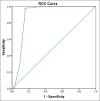Survey of efficacy of pediatric appendicitis score in Iranian patients less than 18 years old referred to the emergency department
- PMID: 31803676
- PMCID: PMC6881965
- DOI: 10.4103/jfmpc.jfmpc_740_19
Survey of efficacy of pediatric appendicitis score in Iranian patients less than 18 years old referred to the emergency department
Abstract
Introduction: Abdominal pain, in particular appendicitis, is a common cause of emergency department visits in children. Therefore, early diagnosis is very important. There are different scoring systems for the diagnosis of appendicitis. This study is the first study to evaluate the performance and accuracy of pediatric appendicitis score (PAS) in Iranian children with abdominal pain in emergency departments.
Methods: This is a cross-sectional study of children under 18 years with suspected appendicitis who were referred to the emergency medicine department of hospitals affiliated to SBMU during 2015. Acute appendicitis was determined according to pathological findings, and final PAS scores were calculated for all children. With statistical analysis, comparison between two groups was calculated and the diagnostic accuracy of PAS score was estimated.
Results: 88 children with mean age of 10.5 ± 3 were studied. According to clinical examination 58 of the children were suspected to have acute appendicitis and 30 others were healthy. In current study, the diagnostic accuracy and precision of PAS at cutoff of 5.5 in patients younger than 18 years admitted to the emergency department with suspected acute appendicitis was 91% and 92%, respectively. Sensitivity, specificity, positive predictive value, and negative predictive value were 93.88%, 86.21% and 92%, 89.29%, respectively.
Conclusions: The results of current study showed that PAS has high diagnostic predictive value for the diagnosis of acute appendicitis in children under 18 years and due to the advantages listed for this score, its use is recommended for children in emergencies.
Keywords: Diagnostic accuracy; emergency; pediatric; pediatric appendicitis score (PAS).
Copyright: © 2019 Journal of Family Medicine and Primary Care.
Conflict of interest statement
The authors declare that there is no conflict of interest that could be perceived as prejudicing the impartiality of the research reported.
Similar articles
-
Prospective validation of the pediatric appendicitis score in a Canadian pediatric emergency department.Acad Emerg Med. 2009 Jul;16(7):591-6. doi: 10.1111/j.1553-2712.2009.00445.x. Epub 2009 Jun 22. Acad Emerg Med. 2009. PMID: 19549016
-
Pediatric Appendicitis Score for Identifying Acute Appendicitis in Children Presenting With Acute Abdominal Pain to the Emergency Department.Indian Pediatr. 2022 Oct 15;59(10):774-777. Epub 2022 Aug 10. Indian Pediatr. 2022. PMID: 35959758
-
Diagnostic reliability of pediatric appendicitis score, ultrasound and low-dose computed tomography scan in children with suspected acute appendicitis.Ther Clin Risk Manag. 2017 Jul 6;13:847-854. doi: 10.2147/TCRM.S134153. eCollection 2017. Ther Clin Risk Manag. 2017. PMID: 28740395 Free PMC article.
-
Abdominal Ultrasound and Its Diagnostic Accuracy in Diagnosing Acute Appendicitis: A Meta-Analysis.Front Surg. 2021 Jun 28;8:707160. doi: 10.3389/fsurg.2021.707160. eCollection 2021. Front Surg. 2021. PMID: 34262936 Free PMC article.
-
Related Markers for the Precision Diagnosis of Complex Appendicitis in Children.Front Pharmacol. 2022 Mar 31;13:865303. doi: 10.3389/fphar.2022.865303. eCollection 2022. Front Pharmacol. 2022. PMID: 35431963 Free PMC article. Review.
References
-
- Sivit CJ, Siegel MJ, Applegate KE, Newman KD. When appendicitis is suspected in children. Radiographics. 2001;21:247–88. - PubMed
-
- Balthazar EJ. Appendicitis: Prospective evaluation with high resolution CT. Radiology. 1991;180:21–4. - PubMed
-
- Ohmann C, Yang Q, Franke C The Abdominal Pain Study Group. Diagnostic scores for acute appendicitis. Eur J Surg. 1995;161:273–81. - PubMed
-
- Fenyö G. Routine use of a scoring system for decision-making in suspected acute appendicitis in adults. Acta Chir Scand. 1987;153:545–51. - PubMed


